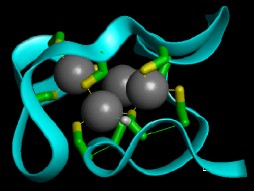
Construction
of
Transgenes
Transgenes
combine DNA sequences
from
different organisms. The example shows an experimental transgene
that
combines a bacterial promoter sequence, a bacterial
reporter
gene, and a eukaryotic
structural
gene,
that is any protein-coding gene. Induction of the bacterial promoter
causes transcription
of the bacterial and the
linked
eukaryotic gene sequence. Expression of the bacterial
gene "reports" successful
transcription: if the
eukaryotic gene is transcribed in
the correct reading frame, the protein can then be properly
translated from the mRNA.
Typical
bacterial
promoters may turn a gene on only to a limited degree. "Strong" promoters
turn on rapid-response systems,
e.g.
acute environmental challenges such as exposure to heavy
metals. Metallothionen is a
cysteine-rich
protein that chelates (binds and sequesters) multiple heavy metal
ions
per molecule.The Metallothionen Promoter
(MP) is a commonly used "strong promoter" that can be induced by
artificial exposure to metal ions in culture.


